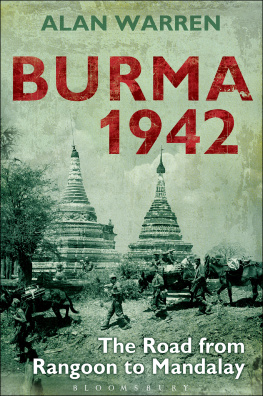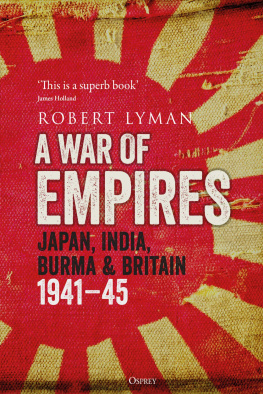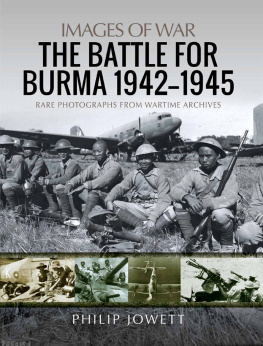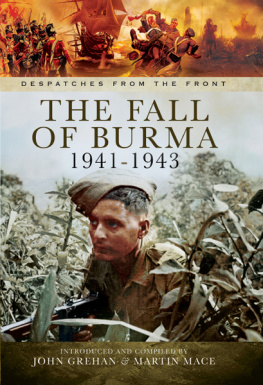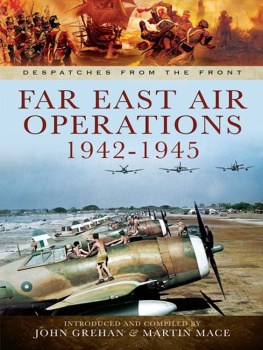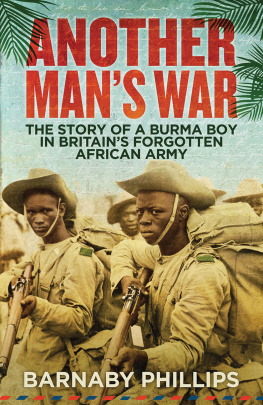Burma 1942
The Road from Rangoon to Mandalay
Alan Warren
Bloomsbury Academic
An imprint of Bloomsbury Publishing Plc
50 Bedford Square | 1385 Broadway |
London | New York |
WC1B 3DP | NY 10018 |
UK | USA |
www.bloomsbury.com
Bloomsbury is a registered trade mark of Bloomsbury Publishing Plc
Alan Warren, 2011
Alan Warren has asserted his right under the Copyright,
Designs and Patents Act, 1988, to be identified as Author of this work.
All rights reserved. No part of this publication may be reproduced or transmitted in any form or by any means, electronic or mechanical, including photocopying, recording, or any information storage or retrieval system, without prior permission in writing from the publishers.
No responsibility for loss caused to any individual or organization acting on or refraining from action as a result of the material in this publication can be accepted by Bloomsbury or the author.
British Library Cataloguing-in-Publication Data
A catalogue record for this book is available from the British Library.
ISBN: HB: 978-1-4411-5250-3
ePUB: 978-1-4411-0673-5
ePDF: 978-1-4411-3370-0
Library of Congress Cataloging-in-Publication Data
A catalog record for this book is available from the Library of Congress
Table of Contents
The city of Rangoon, the capital of the colony of Burma, lay on the north bank of the broad, muddy Irrawaddy river, twenty-five miles inland from the sea. Glittering in the sunlight, an immense volume of water flowed past the city towards the Bay of Bengal. The waterfront of Rangoon was crowded with acres of docks, warehouses and rows of steel cranes.
On the eve of the Second World War Burma was the worlds largest rice exporter. Millions of people a population greater than Burmas own were dependent on the supplies of rice loaded into the holds of freighters by the ports Indian labour force, under the watchful eyes of shipping agents and the representatives of merchant houses. On the banks of the river above the docks were timber mills; teak log rafts were floated down river from the forests of northern Burma to be sawed in the mills.
Beyond the docks lay a thriving commercial district, the citys main railway station and the governments office buildings. Rangoon was a bustling metropolis and had acquired something of the atmosphere of colonial Shanghai. A rectilinear grid of wide, straight streets had been laid out shortly after Britains permanent annexation of the city in 1852. Solid bank architecture was in abundance on the main thoroughfares; American motorcars, buses, bullock carts and rickshaws jostled with pedestrians for right of way; the market stalls of the bazaars presented a colourful scene. Women with coiled black hair and high cheekbones carried baskets on their heads, and wore dresses made of brightly coloured materials. The citys mostly Indian and Burmese populace lived in crowded residential districts beyond the city centre. Down river at Syriam, the tall chimneys of the Burmah Oil Companys refinery made the air grey and misty with smoke.
Near the Governors House, the golden shrine of the Shwedagon Pagoda shimmered magnificently over Rangoon and dominated the skyline. The great pagoda was one of the most revered places of pilgrimage in the Buddhist world, and the principal historical reason for the citys existence at such a location. The golden, gilt-covered spire of the pagoda rose 300 feet into the air above a terraced platform on a hill surrounded by the slender, gold-tipped spires of smaller pagodas and shrines. On the stairways to the raised terrace, and banked around foreground shrines, masses of flowers marigolds, lotus and jasmine scented the air with strong perfume. Carved stonework featured guardian ogres, winged gorgons and other fabulous beasts. The pagodas were tended by shaven-headed priests in robes. By night the towering Shwedagon Pagoda loomed mysteriously through the darkness.
On 23 December 1941 Burma seemed far from the dramas of the war underway in Europe. After the fall of France to Nazi Germany, the British Isles had been blockaded and was only separated from occupied Europe by the width of the English Channel. Japans recent raid on Pearl Harbor and invasion of British Malaya had been a major jolt to Burmas colonial rulers. Anxiety was growing beneath the surface of local society, though an exterior effort to remain calm prevailed; a manner that was often misinterpreted as complacency by journalists on fleeting visits to the colony.
Rangoon was dangerously close to Japanese airfields in Thailand and Indochina. The city was protected by a single radar unit and a thin chain of observer posts in the jungle-clad mountains of the Thai-Burma frontier. The observer corps was dependent on the civilian telephone system to send messages to the Royal Air Forces headquarters. Rangoon was without anti-aircraft guns; few shelters were prepared for the civilian population.
At Mingaladon airfield, fifteen miles to the north of Rangoon, a small force of Allied fighter aircraft stood ready to oppose any Japanese incursions into the skies of southern Burma. The RAFs No. 67 Squadron was equipped with Buffalo fighters; most of the squadrons pilots were New Zealanders. The second of the two fighter squadrons at Mingaladon belonged to the American Volunteer Group and flew P-40B Tomahawks. This squadron was one of the Flying Tiger units raised to aid Nationalist China in its war against Japan. Mechanics had awoken before daylight to arm, fuel and warm-up the engines of aircraft. A dawn patrol was flown, after which pilots breakfasted and lounged in the shade of tents not far from the gravel runways.
The Japanese Air Force had paid little attention to southern Burma in the early days of the Pacific war, but Japanese commanders had decided to disturb Rangoon from its slumbers. Just before 10 a.m. on 23 December, a fine tropical day, the operations room at Mingaladon airfield received a report of approaching hostile aircraft. The sirens rang out in downtown Rangoon, though many people dismissed them as another practice alert. There were a few clouds in the air and a light breeze blew from seaward.
A large force of Japanese bombers and fighters had taken to the skies from airfields in Thailand and Indochina. The raiders sped westwards through the air towards Rangoon over the glittering waters of the Gulf of Martaban in tight V-formations. Many of the bombers were twin-engine Ki-21 Mitsubishis. The wings of the twin-engine bombers were set back at the midpoint of the fuselage to give a hawk-like silhouette. The 2200-pound bomb load carried by the aircraft was sufficient to do a great deal of damage to a crowded city of the orient. The Mitsubishis were painted pale grey underneath and light brown and green on the upper side; red discs on the wings and fuselage proclaimed the nationality of the bomber. The city and Mingaladon airfield were the intended targets. The warehouses along the docks were crammed with American military supplies destined for transport to Nationalist China along the fabled Burma Road.
At Mingaladon Allied pilots ran for their aircraft; climbed into cramped cockpits; put on radio headphones; adjusted their parachute harnesses; switched on their radios. The engines coughed and roared into action. The pilots eased forward on the throttle to taxi to the end of the runway for a hasty take-off. A dozen Tomahawks and fifteen Buffaloes took to the air through clouds of dust. The pilots retracted the landing gear of their aircraft, and climbed in circles towards 20,000 feet under a blinding sun. The propellers of the fighters hungrily clawed at the tropical air. From high above, the runways of Mingaladon formed a light coloured triangular shape, surrounded by patches of vegetation and green-brown rice fields.
Next page
